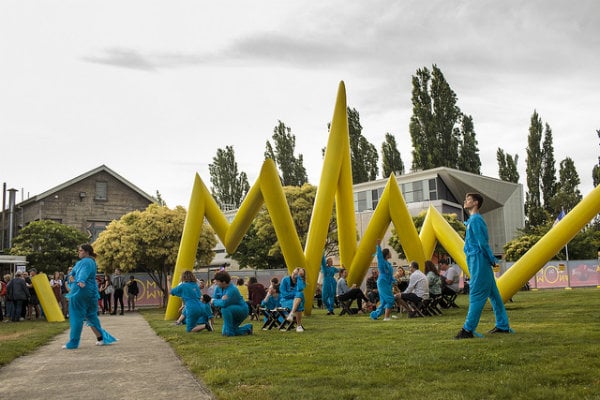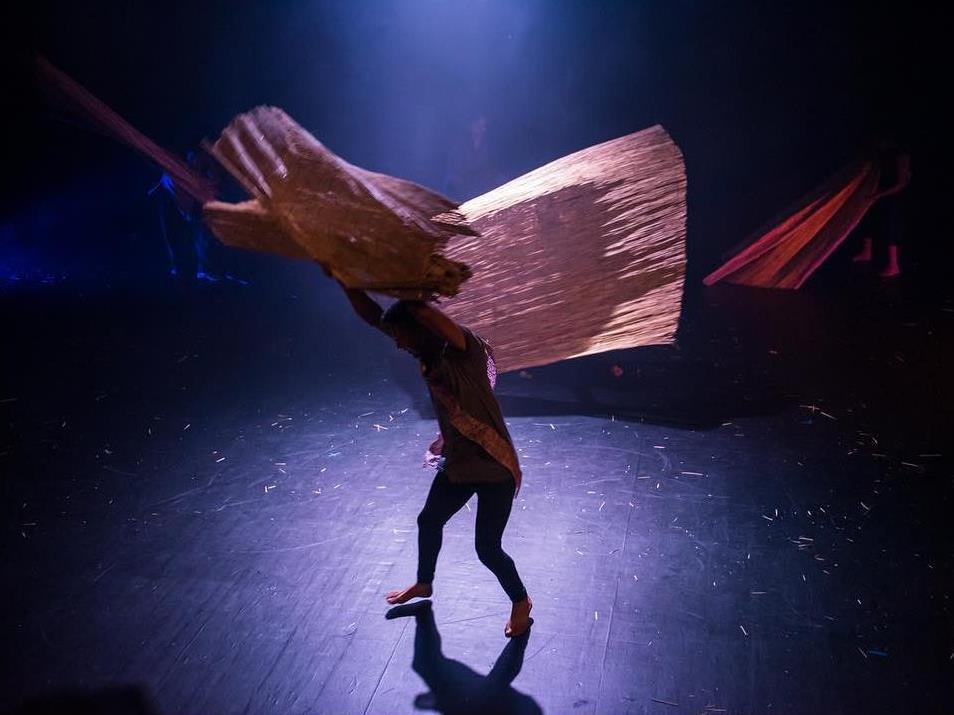Tasdance’s Yatra at Mona Foma. Photo credit: Emily Dimozantos.
Until recently, Lesley Graham covered local and visiting performances for over 20 years for The Mercury, until the paper ended the contract of its Arts Editor and its commitment to publishing performing arts reviews. Here is her summary of the dance and physical theatre program at the latest MOFO in Launceston.
* * *
Tasdance, now under the direction of Adam Wheeler, performed two works in the festival. Apart from the short cabaret style improvisation with Japanese sound artists Group A in the late-night (sold out) Faux Mo, the focus of their activity was on the premiere of Yatra.
This intriguing work was billed as a collaboration between Tasdance and members of the local Bhutanese community. Directed by Wheeler and Gabriel Comerford, the eight-month development has mined rich material and mutual understandings, which have translated into a joyous expression of tradition and transformation. The contributions of over 30 Bhutanese artists are integral to the shape, sound and content of the work.
A snaking circle of rolled mats leads the audience to their seats. Out of the deeply smoky space emerges a delicate solo focusing on rippling hands. Utilising the raised encompassing seating of the Inveresk Theatre, the performers re-enter with the woven reed mats, which become the focus of manipulation around village life, challenge and construction. Although there is a clear sense of narrative here, it is the incidental images which seem the strongest. As the mats are manipulated, they shed pieces, like leaves, hair or skin, leaving a memory of their scattered presence. Likewise, the shear weight of the sacks, dragged and stacked as lookouts, is tangible and their texture both giving and forgiving.
The cast is a mixture of community and professional dancers, and the communication and play between them seems fluid and genuine. Comerford, himself performing, assists in the articulation of ideas without taking away from the presence and strong intent of the community members. Yatra has integrity as a work, which could extend well beyond this successful community project.
Also following Festival Director Brian Ritchie’s aim to shine a light of the artistic jewels of northern Tasmania, youth dance company, Stompin, performed a series of pop ups all over the festival’s Inveresk site. Directed by Caitlin Comerford, Chameleon follows its reptilian namesake by responding to the surrounding environment. The 16 young performers appeared in indoor and outdoor spaces including a gallery, a disused tram way and a busy festival food van lawn.
Each venue is treated with fresh ideas, with dancers grouped, elevated, posed and running between objects and people in the space. Between these site-specific responses, more structured interactions occur between company members in duos and trios leading back to whole group responses based on structural features in the space.
While the work has a familiar structure, it is always the detailed and unexpected interactions with audience and the performances of some of these very committed dancers which elevate and delight.

Stompin, Mona Foma 2019. Photo Credit: MONA/Rémi Chauvin. Image courtesy of the artist and MONA Museum of Old and New Art, Hobart.
As with each MONA FOMA, Ritchie invites a touring dance artist to perform an Australian premiere and the audiences flock to his choice. This year’s work is anOther by Canadian Dana Gingras (choreographer and performer), Sonya Stefan (media artist) and Group A (sound artists from Japan). The work follows the 2018 MOFO remounting of Gingras’ highly acclaimed Monumental.
anOther is a very different work both in scale and vision. Inspired by the infamous subway scene in Andrzej Zulawski’s cult film Possession, it is set in the intimacy of the Earl St Theatre and is really more of an installation with raked seating for the observers rather than the huge theatrical undertaking of Monumental at the equally packed Princess Theatre.
Highly reflective black plastic covers everything except over 16 flickering screens. Strengthened by the elevation of the audience, there is a strong sense of delving underground. There is a glimpse of a figure on stage operating a keyboard and producing immersive sound, so loud the whole building vibrates and digital static bounces off the shiny roof. After a nail-bitingly long period, two musicians become vaguely visible and the solitary figure creeps around the edges of the space seemingly avoiding detection save an occasional hand placed on a screen.
Eventually an obscured figure on the floor slowly shifts. Transparent black folds catch the light as the sounds become more animalistic and the screens occasionally project stills of a blurred figure. Vaguely human, but also insect-like, alien, the plastic figure twists on itself, building expectation that something might break the tension. Instead the simple layers of sensation continue to intensify as the carapace is shed. With only the light from the screens illuminating the evolved figure, sound and imagery shifts pace with the introduction of a vague melody and Gingras now responds to the rhythms with trance-like quivering, shaking and outstretched arms. For some the repetition is cathartic. The constant movement embraces and embodies the music.

anOther: Dana Gingras and Group A + Sonya Stefan, Mona Foma 2019. Photo Credit: MONA/Jesse Hunniford. Image courtesy of the artist and MONA Museum of Old and New Art, Hobart.
The calmness of a voice cuts through. The alien is now more human with corresponding imagery of teeth and a face. Child-like voices correspond with more flowing movement and slow shifting of weight. Each discipline seems to be travelling a similar path; coexisting rather than reliant.
Gingras again shifts from a ‘pear slug’ state back into a being wrapped in a red textured covering. Without any knowledge of the source of inspiration, it is easy to see this as a simple evolutionary process of infection and crystallisation, but there are obviously many possible interpretations.
The audience response is united, but it is clear some are ecstatic and some relieved.
Other dance artists performing, at the again sold out Faux Mo, were Launceston based dance maker, Cat Freeman, and Tasmanian pakana artist, Sinsa Mansell.
MONA FOMALaunceston, Tasmania
17-20 January





